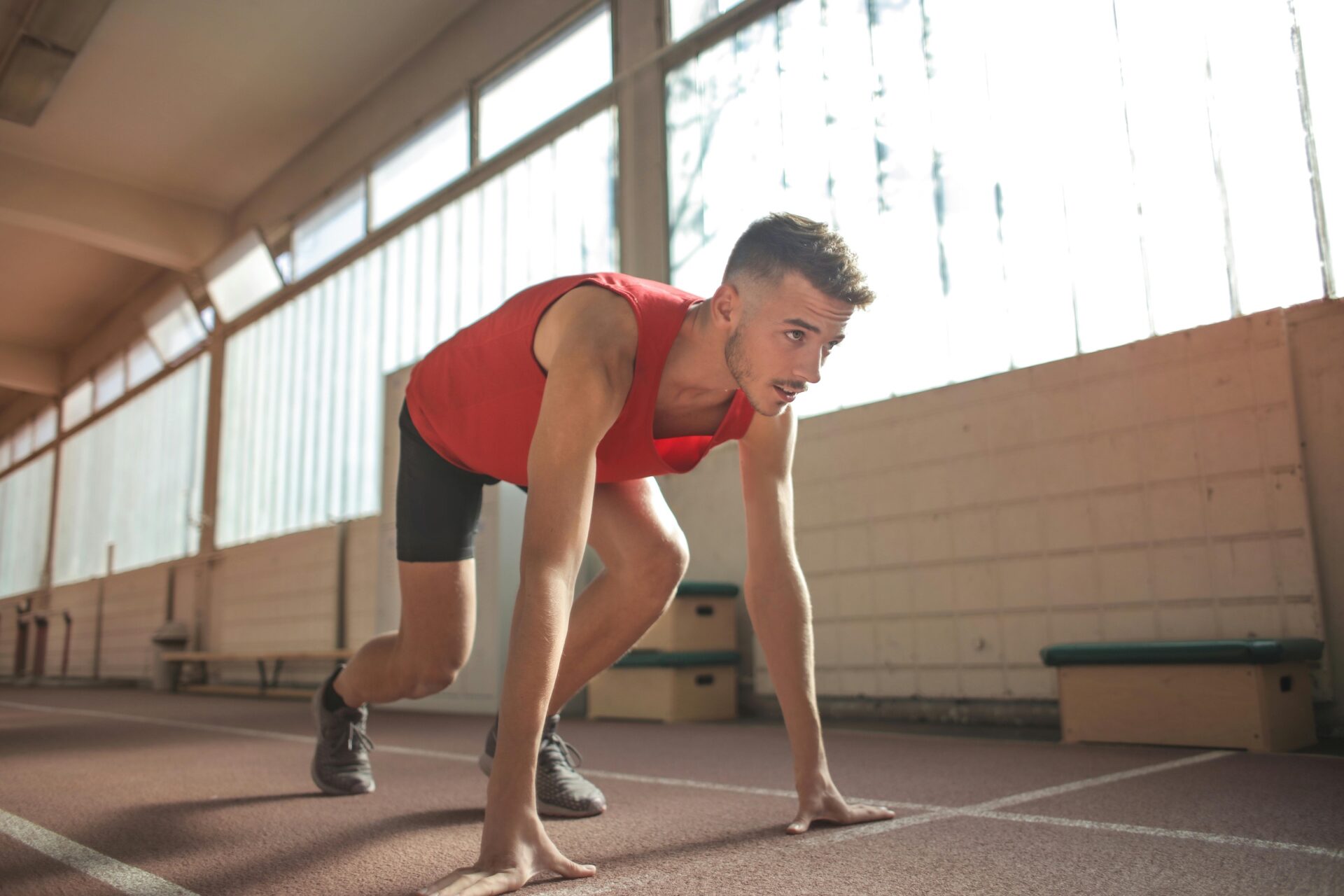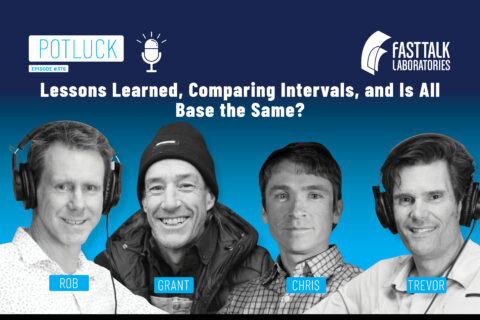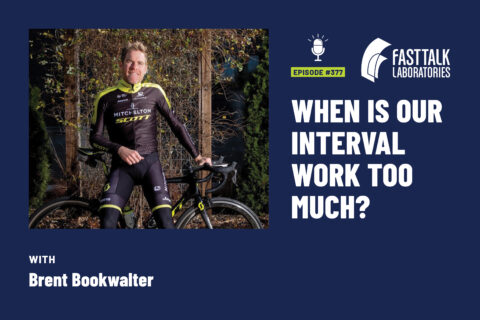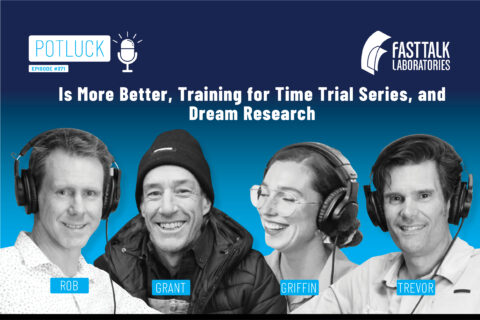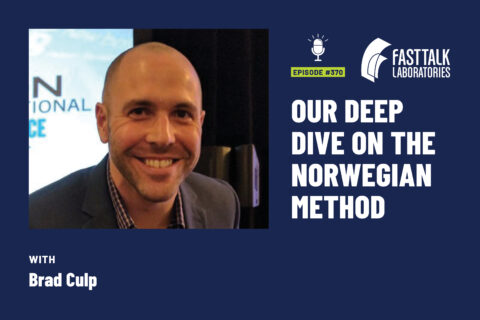In this first episode, Connor and Fretz tackle a question you’ve surely asked yourself: Why aren’t you a pro? What makes them different?
Episode Transcript
Intro 0:00
Welcome to Fast Talk, a VeloNews podcast and everything you need to know to ride like a pro.
Caley Fretz 0:20
Hello and welcome to Fast Talk. I’m Caley Fretz, senior editor here at VeloNews, across the table from Trevor Connor, our longtime training columnist. The purpose of this podcast is simple: to make you a better, faster, fitter bike rider.
Caley Fretz 0:33
Today, we’re covering a big question. What makes a pro a pro? Is it physiology or mental strength or something else entirely? We’ll talk to retired pros Carter Jones and Chris Baldwin, as well as Cannondale Drapac’s team doctor Kevin Reichlin to get some answers. But first, since this is the first Fast Talk podcast, who are we?
Caley Fretz 0:52
Let me tell you about Trevor. Trevor writes the training columns and every issue of VeloNews and has a master’s in exercise bioenergetics and nutrition. Say that five times fast. He also raced for more than a decade on the North American pro circuit and was a manager of development team Rio Grande, which has sent numerous riders to the pro ranks. In short, he knows what he’s talking about – physiology, and the bike racing.
Trevor Connor 1:13
And let me tell you a little bit about Caley. Caley is an editor at VeloNews. He has covered five Tour de France’s, six gyros, the Olympics, just about anything that involves a bike. And he writes many of the stories that you read on VeloNews.com. Can’t tell you how often I’m out for a ride and somebody says, “Hey, did you see that article?” And I get to say, “Yeah, I know that guy.” He likes to say in a former life, he was a cat, one roadie, and a pro mountain biker though he can still rip it up with the best of them here in Boulder. He definitely knows what he’s talking about. And if he doesn’t, the great thing about Caley is he has access to all the pros and all the coaches out there who can tell him.
Caley Fretz 1:51
That is very much part of my job as a reporter. Not knowing answers and finding people who do. And that’s a big part of this podcast.
Trevor Connor 1:57
What Caley and I were really excited to bring to you is we go and talk to these pros. We talk to these top coaches, we talk to these physiologists. In the course of researching these articles for you, we have these amazing conversations, we see all these amazing things behind the scenes. Then when we finally get down to our computer where you have two pages, and as much as we work to really bring to you the best article we can bring, we always sometimes leave it with “Ah, we wish the listeners could have heard that conversation.” That really motivated this podcast. Doing this in an audio format, we can actually bring to you some of these interviews that we’ve had, some of these conversations that we had.
Caley Fretz 2:34
The whole story, so to speak. So our goal here is to take you inside some of the burning questions. And to that end, let’s make you faster.
Caley Fretz 2:44
Why are we not professional cyclists? What makes them so much better? That is the question we’re trying to answer this week. And with that, I turn it over to Trevor to give us at least a bit of a synopsis and an overview of sort of the main reasons why they are so much better than we are.
Trevor Connor 3:01
Yeah, so Caley and I both have real — here. Why aren’t we pros? We think it’s all about numbers. We think it’s all about what you can do on Strava. But there’s actually a much more complex answer to this question that involves physiology, involves luck, involves who you know, billing. You are to live this lifestyle. So let’s address a few of these sides.
Caley Fretz 3:26
So, your average amateur bike racer. Probably has a power meter or has tested themselves on one at some point. Is there a number where if you hit five and a half watts per kilo for half an hour, you’re guaranteed a pro contract? Does that exist?
Trevor Connor 3:44
Yeah, I mean, the numbers are important. And there are certainly numbers that get floated around there, when they talk about threshold. If you want to be top in the world, right around 6.5 watts per kilogram is the right number. And I don’t have a calculator in front of me. But if you take your average 160-pound rider, that’s a pretty high number. That’s up over 400 watts. Another number that’s actually thrown out a lot at the very highest level, but you don’t hear at lower levels, but it’s actually very important – especially for events like the Tour de France – is this sustainable wattage. Why did you hold what’s called your aerobic threshold? Hopefully we’ll cover that in another podcast, and that’s 4.5 watts per kilogram. Again, for that 160-pound rider, we’re talking around 300 watts, three to 320 watts. What’s important about that number is that’s what you can sustain for four or five hours. So if you want to be in the Tour de France, you need to be able to ride at 300, 320 watts for the length of an entire stage. Which for most of us amateurs that’s your threshold. That’s what you can do for 20-30 minutes.
Caley Fretz 4:54
If you’re good. I mean 320, you’d be a cat one on 320 watts, right?
Trevor Connor 4:59
Yeah. So they are impressive numbers. But if you talk to a lot of pros, they really hit their peak numbers very early on in their careers, and long before they hit top pro. So it wasn’t those numbers that set them as pros.
Caley Fretz 5:10
We caught up with Carter Jones, a former pro with Jai Appleson and Urato with a physiology background – degree from CU, in fact – to ask him about the way his physiology differs from amateurs, and how that affects the way he trains versus the way we train.
Carter Jones 5:25
So the first thing that came to mind is repeatability of efforts. LT or above LT, and being able to do those efforts later in races. We’re talking about a year-to-year development type thing here. It’s kind of interesting. If you look over my files, back when I was 19 or 20, I was still doing relatively similar 10-minute power 20-minute power, but now I can do that at the end of a race, or I could do that two or three times. So that’s been the big difference in my progression. But a lot of people think, “Oh, yeah, I can go out and do a 20-minute test. And I can climb with Chris Froome, or whatever.” And it’s like, you got to do that after so many days and that far into a race and there’s so many variables that you can account for. Assuming VO2 max is relatively fixed genetically, you obviously can manipulate it. With your weight, it is trainable. But once you’re MLB level, you’re kind of stuck with what you got. You can’t really worry about that. I haven’t done a video to max test in probably five years, and I don’t ever plan on doing one again unless I’m forced to. So I mean, the LT is definitely the biggest indicator of fitness. And it’s the most trainable, definitely what I would say. I focus most of my training on it, in terms of building it through long endurance days, or LP efforts for obviously, then you do get into the race specific stuff.
Caley Fretz 6:36
So what did set them as pros? He said it was the ability to ride that 80%, for four or five hours.
Trevor Connor 7:05
Yeah, actually, that one is really key when you’re talking about the numbers. And that’s really the overall theme. There has been a lot of research, a lot of studies out there, put out about what makes a top-level pro cyclist? It’s not VO2 max, it’s not max power. You can train in a bit, not a lot. Same thing with the short peak wattages. What you can put out for five seconds, for a minute. That you hit really early on. So there were really three things that they saw that separated out top pros. First and most critical was, what sort of level could they sustain? And what you see in top pros is they can sustain something very, very close to their max level. So max level doesn’t change. But what they can hold gets really close to that. So if you take an amateur rider, you measure their threshold power, it’s going to be 75, maybe 80% of their VO2 max wattage. In a world class time trialer, they can go for an hour at 95% of their VO2 max. Their threshold and their VO2 max are really, really close to one another. So that sustainable five-hour power gets up much closer to their max, and their threshold gets up much closer to their max.
Trevor Connor 8:22
The other changes you see that you wouldn’t think too much about is their energy utilization. Where amateurs will very quickly start relying purely on carbohydrates. Even getting up over threshold, you’re gonna see pros still using fat for fuel. Fat’s unlimited, so they can sustain those power levels longer.
Trevor Connor 8:41
Last one, which we’ll get to at another point, and we’re not going to talk much about today, is what’s called neuromuscular recruitment. Just their ability to use all their muscles better in sync. So what it really comes down to what separates the pros physiologically is this ability to sustain very, very high wattages. And their max wattages are not really that important or not as important.
Trevor Connor 9:07
They did a really interesting study where they managed to get all the numbers for Pierre Rolland from when he was just coming up in the junior ranks to when he was top 10 at the Tour de France. And they saw the same thing again. His short wattages, what can you do for five seconds? What can you do for one minute? He hit all those numbers as a junior. They really didn’t change very much all the way up to where he was a top pro. The numbers, the things that they saw a change in him were his more sustainable numbers. What could he hold for four or five hours? The other big change they saw in him was just this increasing volume of work and training stress. There’s a score called the TSS training score. And you can do a weekly average or you can look at the training stress for each ride. They really looked at his weekly training stress and saw that that went up and up and up. So he was beating up his body more and more each week. And consistently from when he was a junior to a very high level, his training stress went up and his volume of training went up over 100%. And they also found later on as a top pro, he had a lot more weeks with just extremely high training stress that wasn’t sustainable. When he was a junior he’d only have a few weeks that he felt “That week beat me up.” We think of those as like training camps. I just couldn’t sustain that.
Trevor Connor 10:30
Something a lot of people don’t think about, but it’s really important, is support. These pros are, as we talked about, they put out this huge training stress that can really beat them up. But they have a team of, at the highest levels, they have coaches, physiologists, massage therapists, doctors. They’re checking them regularly, making sure they’re handling the training and helping them with the recovery. People are trying to go pro themselves who have a full time job and don’t have the money for these sorts of resources. You can’t handle the same sort of training stress, because you don’t know when you’re starting to fatigue yourself. And you don’t have the people telling you when to back down or helping you to get through it. And that is a really important factor.
Caley Fretz 11:10
Pros like Pierre Rolland can handle a lot more training that we can handle. That’s clear. But that makes them somewhat vulnerable too. We caught up with Cannondale Drapac team Dr. Kevin Reichlin, who explained why.
Kevin Reichlin 11:21
I often say that the pro cyclists are enigmas. In that as long as they stay within their plane of biomechanics, they can handle the volume of training that you and I would get tendonitis or muscle issues, all kinds of stuff. However, the difference is you and I, if we suddenly, let’s see where our seatpost drops two millimeters, or your cleat comes slightly loose, you and I are fine. Whereas it’s disaster because they’re so highly trained within this very specific plane of biomechanical existence. Does that make sense?
Caley Fretz 11:58
So do they need more cross training? Or is that just the way that they are naturally?
Kevin Reichlin 12:04
So I would say for a pro, no. You want them to be strong in that plane of biomechanical existence. Is that the healthiest thing for you or me or my patients, I would rather see you cross train. But then you’re taking away. That said, to the guys that I work with closely in the offseason, I ask them to do a small amount of cross training, just to get their bodies ready for the possible crash. The possible biomechanical irregularity that can creep up with a cleat that comes loose, so that they have a little bit of reserve. But I don’t recommend much, because again, I want them training to be in that biomechanical plane.
Caley Fretz 12:40
So you deal with these guys on a pretty regular basis. Often when they are not at their best. Is there anything else that you notice that makes them slightly different from the rest of us?
Kevin Reichlin 12:44
The first thing I would say is, they get so frustrated when they know that they’re not at their best when they could be. Because their experience of being at their best is so much higher than you and me. And so it’s so frustrating for them to be even a couple of watts down, they can feel it. So that’s one thing I see is a difference. Another thing I see is the difference. And I say this after 11-12 years of working with these guys, if I tell a pro athlete to take time off the bike, they’ll do it. If I tell an amateur wannabe to take time off the bike, they frequently won’t. That’s one thing those guys get. The doc says they got to take off, they will take off. They don’t like it, but they will listen to us. Amateur wannabes won’t. I’m not kidding.
Caley Fretz 13:41
All right. So we’re talking about what are the actual physiological differences between them and us? I mean, are they just that much more efficient? What are the differences internally that are allowing them to maintain that super high level for four and a half hours?
Trevor Connor 13:56
So this is the thing that’s kind of simultaneously optimistic and really depressing. These changes, what you really see that allows pros to have this huge sustainability, to be able to put out these huge numbers very close to their max for a long time, is trainable. Which is fantastic. The depressing side of it is it’s not just going out and doing some intervals for six weeks and getting super strong. Certainly interval work. You can’t win races without it. But those changes peak out pretty quick. What makes pros different, what separates them, one of the bigger ones is this change in efficiency. This is this whole idea of how much power can you put out for every liter of oxygen that you consume. And this is one of the things you really see improve in pros over an extended period of time. Because what happens is, you can’t improve, really, how much oxygen you can consume. So be better at using that oxygen. And that’s basically the definition of efficiency. And what a lot of studies have seen is that does improve in pros, but you’re talking five to 10 years to see those sort of improvements. The other things that you see change, you see improvements in the capillary density around muscles, you can have better oxygen delivery to those working muscles. And another really big one is you see a shift in our fiber ratios. So everybody talks about the importance of slow twitch muscle fibers. Slow twitch fiber muscles, they don’t fatigue, and they are more efficient. So for a cyclist, you want a lot of those. And you want a higher ratio of those. And with a lot of training, those do actually transition. So in top pros, you’re gonna see a higher ratio. Again, genetics plays in there. If you were born with a very low ratio of slow twitch muscle fibers, probably enter World’s Strongest men contests, go be a football player. Don’t try to race in the Tour de France.
Caley Fretz 16:03
And we should clarify, even a guy like Mark Cavendish, in sort of the grand scheme of athletes probably does not have all that much fast twitch, right? Because he still had to ride for six hours first. You compare him to Usain Bolt, and they’re gonna be completely different.
Trevor Connor 16:21
Even in the cycling world. I mean, yeah, Cavendish, from my understanding he peaks out around 1600 watts. So he’s the fastest sprinter after six hours of racing. But when they put him up against a track sprinter, it’s not even a contest.
Caley Fretz 16:36
Right. If what you’re saying is correct, and I can essentially change my muscle fiber composition to look more like what it should look like to be a pro cyclist. Then, how many years is it gonna take for me to turn myself into a slow twitch, pro cycling God?
Trevor Connor 16:55
So that’s the really depressing side. So the cool thing is, yeah, you can cause these transitions, you can improve efficiency. Your VO2 max is not a death statement. You can transition these fiber ratios to much more of what a cyclist wants to see. The downside is it takes five to 10 years. And it’s not just doing an hour a day of intervals. It takes big, big volume to do that. And that’s why you see the pros out training 20 to 30 hours a day. There are gains that you get from big volume, and this is one of them. They’re just not immediate gains. And that’s what you have to do to hit the highest level. And again, you saw that, with the study of Pierre Rolland. What consistently increased each year as he got to where he is top 10 of the Tour de France is this increasing training stress score every week. And the biggest factor in training stress is lots of time at these sub threshold or threshold intensities.
Caley Fretz 18:01
Which is all well and good unless you have a job. And then you pretty much just give up.
Trevor Connor 18:06
Yep. So you want to be a pro. Give up your job, get divorced, sell your kids, train 20-30 hours a week. Otherwise –
Caley Fretz 18:17
Good luck.
Trevor Connor 18:18
I had a chance to catch up with Chris Baldwin, former two time national champion who now coaches here in Boulder at day to day coaching. Chris coaches athletes all the way from top pros down to new amateur riders. And while Chris believes we can hit a high level in very limited volume, to hit the highest levels he has a lot to say about the need for big volume training and its effects on training stress.
Chris Baldwin 19:09
The biggest factor in the training stress algorithm is volume, it’s time on the bike. It’s really hard. You can make up for some of that with intensity and instructure. But really, you’re looking at a set amount of training stress that a limited time athlete has to work with. Whereas a pro can do the 30 hour weeks to hit a higher peak. So absolutely. So with a nine to fiver, I’m a firm believer in aerobic adaptations as being the foundation for successful cyclists. And those adaptations are extremely time consuming. There’s a few ways, a few shortcuts and a few ways to expedite the process. But building FTP, building mitochondrial density and capillary density and these things, they don’t happen quickly. And it just gets harder and harder for a time limited athlete to truly change as an athlete. That’s where a pro can build up.
Caley Fretz 19:38
So let’s talk genetics a little bit. We all like to think that if we worked hard enough, American Dream style, that we could turn into a professional rider. In a sentence, is that true? Is there sort of a genetic predisposition? Taylor Finney is the one that comes to my mind, right? Two phenomenal world class parents and lo and behold, he gets on a bike and a year later, he’s a world class athlete. That would seem to suggest more nature than nurture.
Trevor Connor 20:10
You know, I’ve really done an about face on that one. So I’ll give you my addendum on this. You want to win the Tour de France, you want to be a Chris Froome? Yeah, genetics are a big part of it. That being said, we’re talking about going pro. Yeah, what I used to always hear, what I completely believed was the expression, “The most important thing in cycling is picking your parents right.” Over years of working with athletes and seeing athletes hit the top level, I’ve seen a ton of guys have the genetics, and they go nowhere. Other guys had very mediocre genetics and actually go really far in the sport. I have an old teammate, Rob Britain, in his early days, when he was training at the center with me. Riders of the center were telling him, you should quit. You had no potential in the sport. Last year, he was the top stage racer in North America. So I have really taken about face and all this and said, well, you need genetics for the highest level. You can go very far in this sport just with how you train, with some luck, and a lot of other factors that we’ll talk about.
Caley Fretz 21:16
I look at the people that we used to race with. A little bit of backstory, Trevor and I raced together in college. And for a couple years, we’re sort of mentors for when new students would show up and race in this men seas and women’s bees and things like that. And you’d get kids that would show up and just be actually pretty darn good because they just got on a bike. And then you’d have other kids that would spend all four years racing in the men seas and it didn’t seem to matter how hard they were going to work. But you’re saying that it’s a bit of both? That maybe there is a genetic component. But you can work your way past some of it maybe? Is that accurate?
Trevor Connor 21:57
Yeah, I think I think it’s a whole interesting mix. And you’re a great example of that. Because look, you frustrate the hell out of me. You’ll take a month off the bike, I’ll train my butt off, and then we’ll go out for a ride and you’ll be super strong going up a climb. And it drives me nuts. If I took a month off a bike, and we went out for a ride you’d probably bring a tricycle out just so we’d match pace. But the same thing when we were racing together at CSU that’s another good example. You want a lot of races and you had a lot of results. And I attribute that as much if not more to having a lot of other assets, particularly race smarts.
Caley Fretz 22:33
Have you ever known anybody who had the engine and just couldn’t get out of the runway and never won anything?
Trevor Connor 22:40
I’ve seen it 100 times. And I’m not sure any of those people are going to appreciate me giving their name. So I’ll keep this anonymous. So again, since our first podcast for any of you don’t know, I used to manage an amateur team called Team Rio Grande, which was a development squad. And our goal is to really get athletes to the top level, to get them up into the pro ranks. And the team had a lot of success over 13 years. So obviously one of our biggest names was TJ van Garderen who came through the program. But I can give you a lot of other names. And for every TJ that we saw on the team, there were five guys who had a ton of potential and unfortunately never hit those ranks. And in particular, we had – again, I’ll leave them anonymous – we had one rider on the team who, unbelievably gifted rider, should have been getting top five at the Tour de France. Used to beat TJ as a junior. But when it came to race time, when it came to going into events, I had to pack his bag the night before races. He was eating Twizzlers for dinner and pizza for breakfast before races and not putting together the race strategy. And we could never get him out of the amateur ranks.
Caley Fretz 23:51
So the other important point here is that there are many things you can train if you’re willing to put in the time and effort. But at the end of the day, there’s also luck, which is, did you win the race when the guy who might hire you was there to see it? And then the fact that breaking into that pro lifestyle is incredibly difficult. Generally, the first couple years are going to be terrible. Even if you’re a big talent and you manage to jump straight to a world tour team.
Trevor Connor 24:20
One of the things that’s really painful to see is guys that are riders that put in all the time that have the genetics, and they still don’t make it because of all these other factors that are involved. And one of them is frankly, this is not a glamorous lifestyle. When we traveled the races, you stayed in host housing or often on mats on the floor. People had to keep up jobs. So they’re going and doing a five hour pro race and then the evenings are trying to get their work done. It’s sitting in – Caley can talk about this – sitting in vans driving 28 hours and then trying to race the next day.
Caley Fretz 24:55
Well and the reality is in ways it gets better, but in a lot of ways it doesn’t get better. I’ve now covered five tours of France as a reporter. And we see the hotels these guys get put in. There is no special dispensation for the leader of the Tour de France. As crazy as that sounds. If Chris Froome is leading the Tour de France, he still gets put in whatever hotel he’s put in that night. And it might be a two star terrible, terrible, crappy hotel next to the highway. That’s why those teams started doing things like bringing their own RVs. It’s not a glamorous lifestyle, even all the way up to the very top of the sport.
Trevor Connor 25:34
One of the talks I used to give every year at Rio, one of the first talks is – and I didn’t want to be discouraging, but just give these guys an idea of what was involved. And I said, “Look, here’s the sort of commitment you have to do.”. We talked about 20-25 hours a week on the bike, but then there’s also 10 hours a week off the bike of stretching, core, weights, then there’s recovery time. And so the time you’re dedicated to Cycling is 60 plus hours a week, and then a lot of these guys have to hold down a job as well. That’s your life, you don’t have time for anything else. You get to the races, they are hard, you’re going to crash, you’re going to bandage yourself up and then get back into the race the next day. And all this is completely unreasonable. These are demands that shouldn’t be placed on you. If you’re lucky, you get that pro contract, where you’re making $6,000 a year. What I say to them, is if you’re doing this for the money and the glamor leave now. If you’re doing this for love of the sport, absolutely. This is a fantastic sport. This is a unique sport that I think is more exciting than a lot of other sports out there. And it’s one of the hardest sports out there. So to me, it should have one of the highest levels of accomplishment. But it is unreasonable, what’s expected of you to be a pro. And this all factors in, it’s not just strength.
Caley Fretz 26:59
So we’ll end each of these episodes with a couple concrete take homes as best we can. And they’re less concrete in this particular podcast, then they will be in subsequent episodes. But there are a couple things that we can walk away with, after all this discussion of physiology and genetics and luck, and terrible vans and all the rest.
Trevor Connor 27:19
Yeah, so I think we don’t have any concrete go do these intervals take homes for this one. But I think there’s some really interesting take homes. And the first one, if you’re really thinking about, hey, I want to go pro, the positive and the negative. Positives, I don’t think genetics is the definer of whether you can go pro. I think it is if you want to win the Tour de France, but I think anybody can hit the pro ranks. The downside is you have to be willing to live that lifestyle, you have to be willing to put in the time, the sweat and the sacrifice, which is bigger in this sport than in most sports. I think another key take home here is don’t necessarily just look at Strava to determine who should be pro and who shouldn’t. It’s not those peak numbers, those aren’t really what differentiate you. And if you want to train, your ability to race at that level, what you have to start working is that sustainable power, what can you hold for long periods of time? Your max values aren’t going to go up that much. So it’s getting your threshold really up close to your max and it’s getting that five hour aerobic threshold power, really a PI to be in the pro ranks you have to be you have to have that what a lot of people will think of it as their time trial threshold. And the way you train, that volume is a big factor. You have to do a lot of these longer rides at that aerobic threshold, which is about 80% of your max. But be careful. That’s your first year cycling. Those rides are really damaging, really fatiguing. You have to train for a while before you can even start doing that sort of training.
Caley Fretz 29:00
That has been Fast Talk. Thank you for listening. We’ll see you next time.
